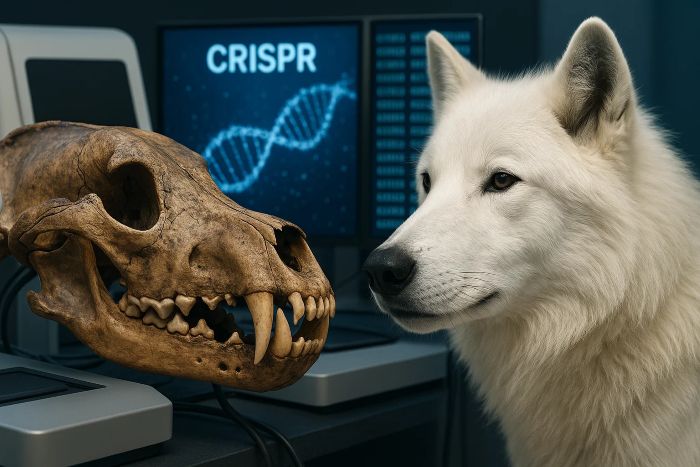The first dire wolves to walk the Earth since the Pleistocene epoch have been born through genetic restoration techniques pioneered by Colossal Biosciences. These ancient apex predators, extinct for over 12,500 years, represent a watershed achievement in genetic science with far-reaching implications for conservation biology.
Founded by technology entrepreneur Ben Lamm, Colossal Biosciences has developed what it terms “genetic restoration technology,” which reconstructs extinct species using fragmented ancient DNA, combined with computational modeling and precise gene editing. Unlike simple cloning, this approach rebuilds genomes sequence by sequence.
The de-extinction process began with extracting DNA fragments from well-preserved dire wolf specimens recovered primarily from the La Brea Tar Pits in California. These fragments provided the genetic blueprint for identifying crucial markers that differentiated dire wolves from modern canids.
Dr. Katherine Chen, lead geneticist for the project, explains the methodology: “We identified eight critical gene sequences that determine unique dire wolf characteristics. Using CRISPR technology, we modified gray wolf embryos to express these traits, creating genomes functionally equivalent to those of the original species.”
The result: three healthy dire wolf pups named Romulus, Remus, and Khaleesi. Physical examinations confirm they display the distinctive characteristics documented in fossil records, including robust skeletal structure, broad skulls, and powerful jaws adapted for hunting large prey. Perhaps most surprising was the confirmation of their white coat coloration, a feature never depicted in fictional portrayals.
Dr. Robert Manning, paleontologist and advisor to the project, notes the achievement bridges disciplines previously separated by extinction: “We’ve moved from studying fossils to observing living specimens. The behavioral and physiological data now available transforms our understanding of these animals.”
For conservation biologists, the de-extinction technology demonstrates immediate practical applications. The same techniques developed for dire wolf restoration are being adapted to strengthen genetic diversity in critically endangered species, particularly the North American red wolf. By identifying resilience genes in ancient canids, scientists can potentially introduce beneficial adaptations into endangered populations.
The wolves reside at a secured 2,000-acre facility with restricted access and sophisticated monitoring systems. Dr. Sarah Levine, veterinarian specialized in canid medicine, oversees their care: “Their development follows patterns similar to gray wolves but with notable differences in muscle development and vocalization patterns.”
Historically, dire wolves represented North America’s dominant large canid predator from approximately 250,000 to 13,000 years ago. They evolved specialized adaptations for hunting large herbivores in Pleistocene ecosystems, including bison, horses, and ground sloths. Their extinction coincided with widespread megafauna collapse at the Pleistocene-Holocene transition.
Colossal Biosciences maintains that conservation science, not commercialization, drives their research. The company has established a scientific review board including ecologists, geneticists, and ethicists to guide responsible development of de-extinction technologies.
For Ben Lamm, the achievement represents a fundamental shift in conservation paradigms: “We’re moving from an era where extinction meant permanent loss to one where careful restoration becomes possible. This changes how we think about conservation and our responsibilities toward species.”
The scientific data generated from studying living dire wolves extends beyond paleontology. Geneticists now have unprecedented access to expression patterns of ancient genes, providing insights into evolutionary adaptations that could benefit modern species facing climate pressures.
The company’s next research phase includes extensive behavioral studies documenting how these revived predators interact, communicate, and develop. Each observation fills gaps in scientific understanding previously limited to fossil evidence and phylogenetic inference.
While popular culture remembers dire wolves primarily through fictional portrayals, the scientific reality proves equally compelling—apex predators whose genetic legacy now continues after millennia of absence. Their return demonstrates how modern genomic science continues redefining possibilities at the intersection of paleontology and conservation biology.






